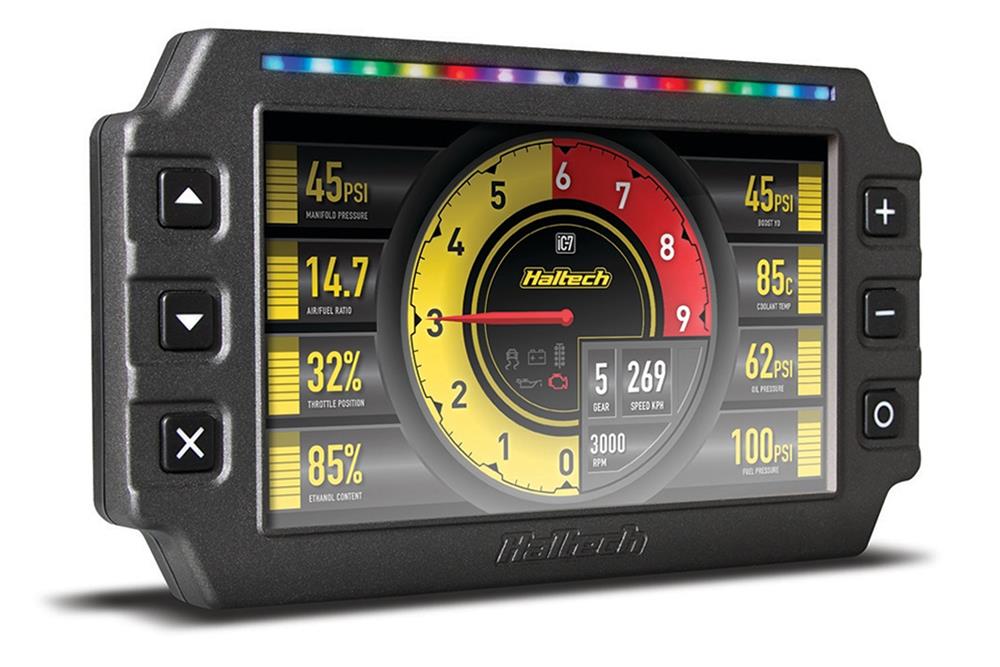Building a race car or doing a late-model engine swap? A Haltech Engine Management System will give you complete tuning flexibility plus data logging capability so you can keep your engine running at peak performance. And when you add a digital dash display and a wiring harness, Haltech can be a one-stop engine management solution.
Here’s a good taste of what Haltech offers—if you’re not sure what engine management system will work best for your application, check out Haltech’s handy ECU buyer’s guide here.

Engine Management Systems
There are three Haltech Engine Management Systems that are particularly versatile. As great options for late model engines and EFI conversions, the universal ECUs use HalTech’s Nexus Software Programmer (NSP) that makes programming easy and intuitive.
The Elite 1500 and 2500 are available with or without a universal wire-in harness with ECU connectors at one end and unterminated wires at the other. The Nexus R3 comes with the universal harness.
Elite 1500
The Elite 1500 is recommended for four-cylinder and two-rotor rotary engines, normally aspirated or forced induction. It has four injector and four ignition outputs plus 12 digital outputs and 10 analog voltage inputs. You can add up to 45 input/output channels via an optional CAN network.
- Onboard data logging with 2MB of internal memory
- Drive-by-wire throttle control
- Tuning setups for gasoline, methanol, ethanol, and LPG
- Flex fuel function—tune boost, fuel, and ignition by ethanol content
- Closed loop O2 control and closed loop idle speed control
- Variable cam control—independently control up to four camshafts
- Sequential turbo control
- Six-stage nitrous control
- Boost control
- Launch and traction control
- Transbrake function for smooth and consistent control of start line staging
- Anti-lag/rotational idle control—build and maintain boost during closed throttle conditions
- Engine protection—set multi-level limits for sensors to protect against common causes of engine failure
- Timer functions—race timer and five additional programmable timers for time-based control of engine parameters, power delivery, and other user definable functions
- Shock travel/ride height inputs allow dynamic tuning and data logging to assist in chassis development and power delivery
Elite 2500
Recommended for four-, six-, and eight-cylinder engines or two-, three-, and four-rotor rotary engines, the Elite 2500 has the same features as the Elite 1500, only it has eight fuel injector and ignition outputs, along with dual channel knock control.
Nexus R3
HalTech calls the Nexus R3 a Vehicle Control Unit. It combines the functionality of a power distribution module, a data logger, a wideband controller, and a state-of-the art engine management system in one powerful device. It can handle engines with up to eight cylinders or four rotors. Other features include:
- Four x 25 amp outputs to power injectors, ignition coils, transbrake, electric fan, and electric fuel pump
- Eight peak/hold injector drivers
- Eight low-current ignition inputs
- 11 0-5V analog inputs
- Onboard wideband controller for NTK and LSU4.9 sensors
- Onboard four-bar MAP sensor
- Two CAN ports with switchable termination
- Onboard data logging (128MB)
- Closed loop boost control
- Anti-lag/rotational idle control—build and maintain boost during closed throttle conditions
- Launch and traction control
- Dual knock control
- Transbrake control
- Variable cam control—independently control up to four camshafts
- Shock travel and ride height control
- Onboard Wi-Fi
- Automatic transmission control for Ford AODE/4R70W, GM 4L60E/4L80E, Toyota A340E, Lenco, and Liberty
iC-7 Color Display Dash

A Haltech iC-7 Color Display Dash replaces a whole dashboard’s worth of analog gauges with a compact display. Features include:
- User-configurable channels, units, and alarms
- Built-in inputs for turn signals, high beams, parking brake, and more
- Adjustable brightness control with automatic dimming
- Programmable multi-color shift light bar
- Face-mounted control buttons
- Software and instructions included
The iC-7 Color Display Dash is available in three versions:
- The standard iC-7 is a plug-and-play unit for all current HalTech ECUs via a CAN network. It also works with other aftermarket ECUs including Link, MaxxECU, Microtech, MoTeC M1 and M400-600-800 gold box, and Syvecs using an adapter cable.
- The iC-7 OBD-II is designed to connect to most 2008 and later vehicles via a CAN network using the factory OBD-II port.
- The iC-7 Classic is a stand-alone unit for vehicles using carburetors, mechanical fuel injection, or EFI without an aftermarket ECU. It has inputs for speedometer, tach, and oil pressure, fuel pressure, coolant temperature, and fuel level. The iC-7 Classis can be used with a Haltech GPS Speed Input Module. Temperature and pressure sensors included.
***
Again, this was just a sample of the Haltech portfolio. See everything Haltech offers here. Oh, and Haltech also gives you a ton of valuable resources on its website too, including a tech library, tutorial videos, and tech tips.

Comments